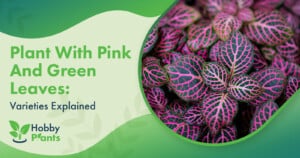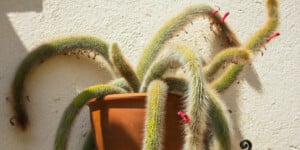Peperomia plants, also known as baby rubber plants, are compact houseplants that require bright indirect light, moderately moist soil, and occasional fertilization.
Varieties with bright colors prefer more light, but cannot tolerate direct sunlight. They do not require frequent pruning or repotting. Maintain a warm ambient temperature and keep in a well-draining container. They may be grown outdoors in zones 10-12.
Peperomia Plant Care and Growing Guide
1. Light
Peperomia houseplants prefer bright indirect light. Some varieties may do well in bright direct light when placed in an east facing window. More variegated peperomia plants prefer more direct light to enhance their natural colors.
Excessive light can cause scorched or sunburned leaves. Insufficient light will result in solid green colored leaves and stunted or slowed growth. It may also cause leggy growth. Leggy branches should be trimmed back and the healthy plant should be allowed brighter sunlight, but never full sun.
2. Water
Maintain moderately moist soil for your peperomia plant and do not allow the soil to dry out completely. Allow the top inch of soil to dry out before watering your peperomia plant. Ensure that the container of your peperomia plant has excellent drainage. Never allow standing water to accumulate.
Do not allow the soil to become soggy as excessive watering may result in root rot. Water from the bottom up to prevent overwatering, especially for peperomia plants that have more succulent-like leaves. Peperomia do not need especially high humidity, but will benefit from occasional misting.
Some varieties of peperomia have more succulent-like leaves and prefer to dry out more than others. For these plants, allow the soil to dry down to about two inches below the top of the soil before watering.
3. Soil
Opt for a loose all-purpose potting soil or sandy succulent soil for your peperomia plant. Potting soil blend may include peat or perlite for healthy peperomia plants. Ensure that the container has excellent water drainage at all times. A layer of gravel or stones at the base of the container will encourage drainage.
4. Climate
Peperomia plants are tropical plants native to South America and prefer a constant indoor ambient temperature between 60 to 80 degrees fahrenheit. Do not allow the temperature to drop below 50 degrees. Ensure that your peperomia plant has good air circulation. Remove dead leaves regularly to improve circulation.

5. Outdoor Peperomia Plants
Peperomia plants are native to tropical rainforests in Central and South America. It may be grown outdoors in zones 10-12. Maintain moderate watering and well-aerated soil in humid climates. Outdoor peperomia plants grow in these environments make excellent groundcover.
6. Flowers and Leaves
Peperomia are bushy plants made up of lush leaves in a wide range of colors, shapes, and sizes. Peperomia are kept for their ornamental foliage that is made up of thick and sturdy stems and fleshy leaves.
The varieties with greater variegation require more sunlight than green-leafed plants to maintain bright colors. Dust your peperomia plant’s leaves regularly to maintain aesthetics and to encourage growth.
Peperomia plants are not known for growing ornamental flowers. In the event that a peperomia plant blooms, the flowers appear as small spikes that protrude from the plant.
7. Rate of Growth
Peperomia are slow growing plants. They do not grow to a very large size and are perfectly content to remain in small-sized containers in indirect light. To encourage faster or more lush growth, fertilize your peperomia plant with a balanced fertilizer as often as once a month.
8. Height and Spread
Peperomia plants, also known as baby rubber plants, are compact ornamental foliage that rarely grow larger than 12 inches in height. They are ideal for containers and small space.
9. Propagation
Peperomia plants are easy to propagate from leaf or stem cuttings. Place cuttings in clean water and allow roots to form, then plant in loose potting soil. Peperomia plant cuttings may also be propagated in the soil. Maintain moist soil and higher humidity for cuttings in soil than is required for mature plants. Peperomia plants may also be propagated by dividing the crown of the plant to produce two smaller plants..
Learn more: Fiddle Leaf Fig Care & Growing Guide
10. Fertilization
Peperomia plants do not require frequent fertilization. They will, however, benefit from light fertilization with a balanced all-purpose fertilizer in the spring and the fall. Do not provide too much fertilizer as the salts may burn the delicate roots.
11. Pruning
Because of their naturally compact size, peperomia do not need frequent pruning. They may be trimmed down for aesthetic purposes or to remove leggy branches. Pruning will encourage the plant to maintain a bushy shape. Remove dead or yellowed leaves to promote healthy growth.
12. Repotting
Repotting peperomia plants is rarely necessary since they grow quite slowly and do not reach a very large size. Opt for a pot that is proportionate to the size of the plant and about 2-4 inches larger in diameter. Repotting may be necessary every two to three years to maintain healthy drainage.
Varieties of Peperomia
Peperomia plants are sometimes known as baby rubber plants or radiator plants. Peperomia are available in a wide variety of interesting shapes and sizes. Due to the wide variety of plants, each will have its own preference as to water and sunlight. Fleshy succulent-like peperomias prefer less frequent waterings and the bold and colorful varieties prefer brighter sunlight.
Similar post: Croton Mammy: Plant Care & Growing Guide
Common Diseases and Pests
Peperomia is sensitive to overwatering and may result in root rot. Peperomia plants may be susceptible to root mealy bugs, aphids, or spider mites. Overwatering may cause fungal growth or mildew. Reduce watering and increase air flow if mildew becomes an issue.
Also read: Orchids: Plant Care and Growing Guide
Conclusion
In order to grow a healthy peperomia houseplant, maintain moderate watering without letting the soil dry out too much. Allow the top inch of soil to dry, then water the plant, being careful not to overwater as this may cause root rot. Peperomia plants do not need regular repotting or pruning as they will naturally maintain a small compact size.
They make excellent indoor plants because of their petite size and tolerance of low light. Increase light allowance to improve growth and color, but never place peperomia plants under direct sunlight. Maintain an ambient temperature between 60 and 80 degrees.
More like this:
- Crested Euphorbia Plant Care & Growing Guide
- Stromanthe Triostar Care & Growing Guide
- Syngonium: Plant Care and Growing Guide
Victoria is the owner and main author of hobby plants. She loves spending her free time in her garden planting and taking care of her plants. Victoria hopes you enjoy the content here!




![Mother Of Thousands Plant [Complete Plant Care Guide] Mother Of Thousands Plant [Complete Plant Care Guide]](https://www.hobbyplants.com/wp-content/uploads/2022/07/mother-of-thousands-plant-300x158.jpg)





![Majesty Palm Plant Care: [Complete Beginner's Guide] Majesty Palm Plant Care: [Complete Beginner's Guide]](https://www.hobbyplants.com/wp-content/uploads/2022/08/majesty-palm-care-300x158.jpg)
![Exotic Angel Plant Care: [Complete Beginner's Guide] Exotic Angel Plant Care: [Complete Beginner's Guide]](https://www.hobbyplants.com/wp-content/uploads/2022/08/exotic-angel-plant-care-300x158.jpg)